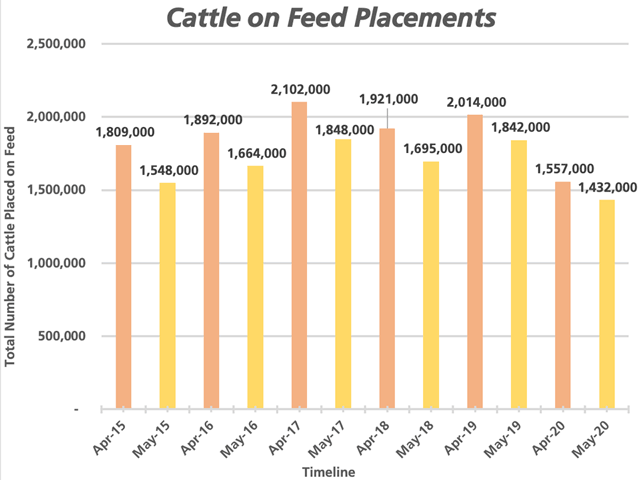Call the Market
Finding the Hole in the Upcoming Feeder Cattle Market
The Cattle on Feed (COF) report is something that most cattlemen know about but only few study and thoroughly understand. Given that the report is a recap of the previous month's happenings, when the percentage only changes by a couple of points, most cattlemen can shrug off its relevance and continue with their day-to-day business. Seeing that the last two COF reports have differed upwards of 22% to 23% compared to placements in 2019, the recap of the reports may hold tangible information about the upcoming fall feeder cattle market.
There's no denying that the two latest COF reports have been plagued (like everything else in our lives and in the marketplace) by COVID-19. Significantly fewer placements have gone into feedlots and, concerningly, fewer fat cattle have left feedlots when they reached their prime. The April COF report shared that placements for the month of March totaled 1.56 million head -- down 23% from 2019, the lowest placements ever for the month of March since the series began back in 1996. May's COF report shared that placements for April totaled 1.43 million head -- down 22% from 2019 and the second lowest that April placements have ever been since 1996.
As cow-calf producers start to kick pairs out to grass and begin to wonder what their fall calves will weigh up to be -- and what prices will ring the top of the market -- producers need to know that this fall's market will be a timing game. Hitting the market at the most financially rewarding time could be a balancing act of gauging when the backlog of cattle is thoroughly processed, and noting when a lull in production arises due to a fewer feeder cattle being placed this summer.
That brings up a ton of questions.
P[L1] D[0x0] M[300x250] OOP[F] ADUNIT[] T[]
How many fat cattle are truly backed up? How much additional weight have those cattle put on? As packers try to increase capacity and get back to efficiently processing cattle, what's going to be the new standard for full-capacity, will it be 70%, 80%, 85%, 90% or fully steady with what it was before COVID-19? What will beef demand be as producers have recently experienced severe sticker shock, possibly leading consumers to other products? And what unknowns are still left to come down the pike?
Working through these questions is challenging as our industry has never dealt with something quite like this before. If we look at the current data provided and study how the market typically goes about its business, we can begin to grasp some of the realities of this upcoming fall.
When digging into the last two COF reports, it's interesting that both reports showed significantly lower placements for the 700-to-799-pound and 800-to-899-pound feeders. This may not seem that concerning, as it makes perfect sense that producers didn't want to put those feeders in feedlots and potentially have them become part of the backed-up supply. However, when looking down the road and comparing this year's numbers to last year's placement totals, the industry will be shy roughly 867,000 head in the next six to eight months, depending on the level of concentration in feed rations.
When fat cattle availability is limited, feeder cattle prices tend to be stronger as the need for getting more cattle on feed becomes a driving factor. In the last couple of weeks, sale barns have seen an uptick in prices as buyers are seeing green grass throughout the countryside and feeder cattle buyers have a hard time saying no to good deals. Even though the market may not be quite where producers would like to see it, it's not far off from being where prices have been in the last couple of years.
| October Feeder Cattle Contract | November Feeder Cattle Contract | ||
| 5/26/2020 | $135.32 | 5/26/2020 | $135.97 |
| 10/31/2019 | $145.95 | 11/29/2019 | $142.27 |
| 10/31/2018 | $153.47 | 11/30/2018 | $145.22 |
| 10/31/2017 | $159.42 | 11/30/2017 | $154.17 |
Moving forward it will be essential that cow-calf producers watch the market avidly and practice great discernment when it comes to marketing this year's calves. Keeping a close eye on slaughter progression, live cattle prices, carcass weights and the upcoming COF placements will help producers focus in on the best time to market their calves. In these unpresented times, relying on marketing strategies that worked in the past will not be enough.
Find the holes within the market and capture the opportunity.
ShayLe Stewart can be reached at shayle.stewart@dtn.com
(c) Copyright 2020 DTN, LLC. All rights reserved.




